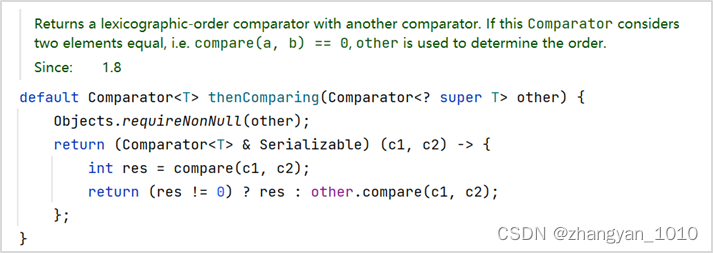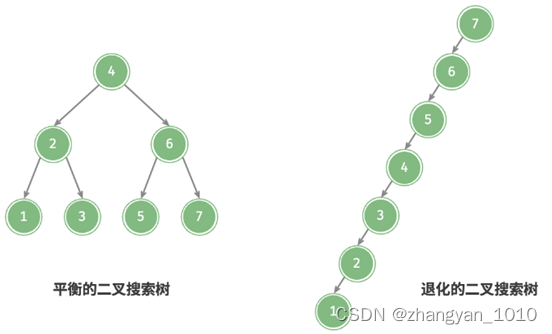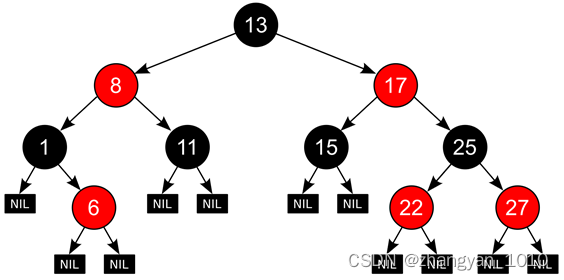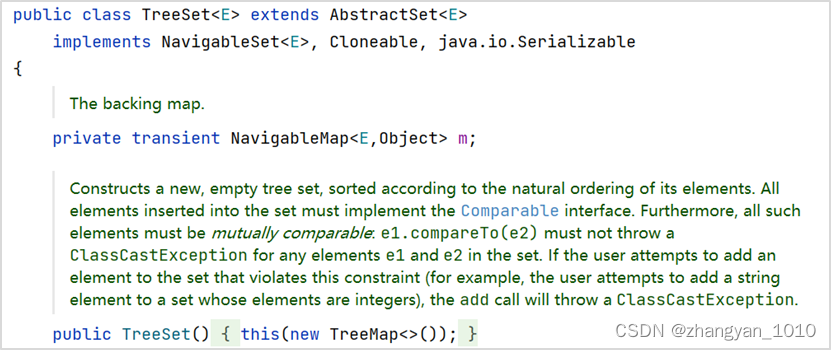1. 集合排序API
1.1 集合排序概述
集合排序是指对一个集合中的元素按照特定规则进行重新排列,以使得集合中的元素按照预定义的顺序呈现。
在集合排序中,通常需要定义一个比较规则,这个比较规则用于决定集合中的元素在排序后的顺序。元素之间的比较可以是数字的大小比较、字符串的字典序比较、对象的属性比较等。
例如,将学生信息集合按照学生的学号排序,按照姓名的字典顺序排序,或者按照生日排序。
在Java中实现集合排序的方式可以分为两大类:
1、使用集合排序API。
2、使用支持自动排序的集合。
- 一些集合底层使用的数据结构支持自动排序,如红黑树结构
1.2 Collections.sort() 方法
Collections是集合的工具类,它提供了很多便于我们操作集合的方法,其中就有用于集合排序的sort方法。该方法的定义为:
void sort(List<T> list)该方法的作用是对集合元素进行自然排序(按照元素的由小至大的顺序)。
编写代码,测试集合的排序实现。代码示意如下:
import java.util.ArrayList;
import java.util.Collections;
import java.util.List;
import java.util.Random;public class ListSortDemo1 {public static void main(String[] args) {List<Integer> list = new ArrayList<Integer>();Random r = new Random(1);for (int i = 0; i < 10; i++) {list.add(r.nextInt(100));}// [85, 88, 47, 13, 54, 4, 34, 6, 78, 48]System.out.println(list);Collections.sort(list);// [4, 6, 13, 34, 47, 48, 54, 78, 85, 88]System.out.println(list);}
}
1.3 Comparable接口
在Java中,如果想对某个集合的元素进行排序,有一个前提条件:该集合中的元素必须是Comparable接口的实现类。
Comparable是一个接口,用于定义其子类是可以比较的,该接口有一个用于比较大小的抽象方法:

所有 Comparable 接口的实现类都需要重写 compareTo 方法来定义对象间的比较规则:
int compareTo(T t); 此方法使用当前对象与给定对象进行比较,并要求返回一个整数,这个整数不关心具体的值,而是关注取值范围:
- 当返回值>0时,表示当前对象比参数给定的对象大
- 当返回值<0时,表示当前对象比参数给定的对象小
- 当返回值=0时,表示当前对象和参数给定的对象相等
编写代码,定义类并实现Comparable接口;然后定义包含该对象的集合,测试其排序效果。代码示意如下:
public class Student implements Comparable<Student>{String String name;String int age;String double score;public Student(String name, int age, double score) {this.name = name;this.age = age;this.score = score;}@Overridepublic int compareTo(Student o) {// 按年龄的大小排序return this.age - o.age;}@Overridepublic String toString() {return "Student{" +"name='" + name + '\'' +", age=" + age +", score=" + score +'}';}
}import java.util.*;
public class ListSortDemo2 {public static void main(String[] args) {Student s1 = new Student("Tom", 18, 88.5);Student s2 = new Student("Jerry", 16, 95);Student s3 = new Student("Lucy", 17, 100);System.out.println("s1 compareTo s2:" + s1.compareTo(s2));System.out.println("s2 compareTo s3:" + s2.compareTo(s3));List<Student> list = Arrays.asList(s1,s2,s3);// 排序Collections.sort(list);// 查看list中的元素for(Student s : list){System.out.println(s); // Jerry, Lucy, Tom}}
}
1.4 Comparator接口
一旦Java类实现了 Comparable 接口,其比较逻辑就已经确定;如果希望在排序的操作中临时指定比较规则,可以通过声明 Comparator 接口的实现类来实现。
Comparator 接口也用于定义比较逻辑,可用于在集合外部提供元素的比较逻辑。对比如下图所示:

因此,实现了 Comparator 接口的类可以看作是定义了特定比较逻辑的比较器。
Comparator接口的核心方法是compare方法,用于比较两个元素的大小:
int compare(T o1,T o2)
实现compare方法的返回值要求:
- 若o1>o2则返回值应>0
- 若o1<o2则返回值应<0
- 若o1=o2则返回值应为0
接续上一个案例:使用Comparator接口,为sort() 方法指定其他比较规则并实现排序。代码示意如下:
import java.util.Arrays;
import java.util.Collections;
import java.util.Comparator;
import java.util.List;public class ListSortDemo3 {public static void main(String[] args) {Student s1 = new Student("Tom", 18, 88.5);Student s2 = new Student("Jerry", 16, 95);Student s3 = new Student("Lucy", 17, 100);List<Student> list = Arrays.asList(s1,s2,s3);// 排序 指定新的比较逻辑 按分数排序System.out.println("====> 按分数排序后的结果");Collections.sort(list, new Comparator<Student>() {@Overridepublic int compare(Student o1, Student o2) {return (int) Math.ceil(o1.score - o2.score);}});// 查看list中的元素for(Student s : list){System.out.println(s); // Tom, Jerry, Lucy}// 排序 指定新的比较逻辑 按分数降序排序System.out.println("====> 按分数降序排序后的结果");Collections.sort(list, new Comparator<Student>() {@Overridepublic int compare(Student o1, Student o2) {return (int) Math.ceil(o2.score - o1.score);}});// 查看list中的元素for(Student s : list){System.out.println(s); // Lucy, Jerry, Tom}// 排序 指定新的比较逻辑 按姓名排列System.out.println("====> 按姓名排序后的结果");Collections.sort(list, new Comparator<Student>() {@Overridepublic int compare(Student o1, Student o2) {// String和包装类都实现了Comparable接口return o1.name.compareTo(o2.name);}});// 查看list中的元素for(Student s : list){System.out.println(s); // Jerry, Lucy, Tom}}
}
1.5 Comparator接口中的默认方法
在Java 8之前,接口中只能定义抽象方法,也就是只能定义方法的签名,而没有具体的实现。
Java 8引入了默认方法(Default Method)的概念,它是一种可以在接口中定义具体实现的方法。默认方法的引入使得Java的接口可以更好地支持类库的演化和功能的扩展。
Comparator 接口在Java 8及以后的版本中引入了一些默认方法,这些方法提供了更多的灵活性和便利性。
以下是Comparator 接口中常用的默认方法:
1、reversed():该方法返回当前比较器的逆序比较器。它将原来的比较规则进行颠倒,使得升序排序变为降序排序,反之亦然。

2、thenComparing(Comparator<? super T> other):该方法返回一个组合比较器,用于对两个比较规则进行联合排序。如果原始比较器认为两个元素相等,则使用传入的 other 比较器进一步比较。

import java.util.Arrays;
import java.util.Collections;
import java.util.Comparator;
import java.util.List;public class ListSortDemo4 {public static void main(String[] args) {Student s1 = new Student("Tom", 18, 88.5);Student s2 = new Student("Jerry", 16, 95);Student s3 = new Student("Lucy", 17, 100);Student s4 = new Student("Alice", 17, 96);List<Student> list = Arrays.asList(s1,s2,s3,s4);// 声明年龄升序比较器Comparator<Student> c1 = new Comparator<Student>() {@Overridepublic int compare(Student o1, Student o2) {return o1.age - o2.age;}};// 声明年龄降序比较器Comparator<Student> c2 = c1.reversed();// 测试效果System.out.println("====> 按年龄升序排序后的结果");Collections.sort(list, c1);printList(list);System.out.println("====> 按年龄降序排序后的结果");Collections.sort(list, c2);printList(list);// 声明分数升序比较器Comparator<Student> c3 = new Comparator<Student>() {@Overridepublic int compare(Student o1, Student o2) {return (int) Math.ceil(o1.score - o2.score);}};// 组合比较器:先按年龄降序,年龄相同按分数升序Comparator<Student> c4 = c2.thenComparing(c3);// 测试效果System.out.println("====> 按年龄降序,年龄相同按分数升序排序后的结果");Collections.sort(list, c4);printList(list);}public static void printList(List<Student> list) {for(Student s : list){System.out.println(s);}}
}
2. 自动排序的集合
2.1 树数据结构
树(Tree)是一种常见的非线性数据结构,它由一组节点(Node)和节点之间的连接关系(边,Edge)组成。树的结构类似于自然界中的树,由根节点、分支节点和叶子节点构成,分支节点连接多个子节点,而叶子节点没有子节点。

2.2 二叉搜索树
二叉搜索树(Binary Search Tree, BST)满足以下条件:
1、对于根节点,左子树中所有节点的值 < 根节点的值 < 右子树中所有节点的值
2、任意节点的左、右子树也是二叉搜索树,即同样满足条件 1

这个特性使得在二叉搜索树中进行查找操作非常高效。在理想的情况下,二叉搜索树是“平衡”的,这样就可以在logn轮循环内查找任意节点。
BST的插入和删除操作也相对简单,但它没有强制性的自平衡机制,可能导致树的不平衡性,如果二叉树退化成链表,这时各种操作的时间复杂度也会退化为O(n)。

2.3 红黑树
红黑树(Red-Black Tree)是一种自平衡的二叉搜索树,它在普通二叉搜索树的基础上添加了额外的规则来保持树的平衡。红黑树的命名源自于每个节点都有一个颜色属性,可以是红色或黑色。
红黑树通过遵守以下五条规则来保持树的平衡性:
- 每个节点要么是红色,要么是黑色
- 根节点是黑色
- 每个叶子节点(NIL节点)都是黑色
- 如果一个节点是红色的,则其两个子节点必须都是黑色的
- 从任意节点到其每个叶子节点的简单路径上,黑色节点的数量相同
示意如下:

2.4 TreeMap
在Java中,TreeMap 是一种实现了 SortedMap 接口的有序映射集合。它基于红黑树(Red-Black Tree)数据结构来实现,可以确保其中的元素按照键的自然顺序或者自定义比较器进行排序。TreeMap 提供了一系列方法来操作键值对,具有快速查找、插入和删除的特性。
以下是 TreeMap 的一些特点和用法:
1、键的有序性:TreeMap 中的键是有序的,这是因为它基于红黑树来实现。键的排序可以是键类型的自然顺序,或者通过传入的 Comparator 对象来定义。
2、查找效率:由于红黑树是一种自平衡的二叉搜索树,TreeMap 中的查找、插入和删除操作的时间复杂度都是 O(log n),其中 n 是映射中键值对的数量。
3、允许 null 键:TreeMap 允许 null 键,但要注意在自定义比较器中处理 null 键的情况,否则可能导致异常。
TreeMap充分发挥了二叉搜索树的特点,为用户提供了一些与Key元素大小相关的方法。

编写代码,测试TreeMap的使用。代码示意如下:
import java.util.Map;
import java.util.SortedMap;
import java.util.TreeMap;public class TreeMapDemo {public static void main(String[] args) {TreeMap<Integer, String> treeMap = new TreeMap();treeMap.put(5,"Tom");treeMap.put(3,"Jerry");treeMap.put(9,"Lucy");treeMap.put(2,"Tony");// 遍历TreeMapfor(Map.Entry<Integer, String> entry : treeMap.entrySet()){System.out.println("key: " + entry.getKey()+", value: " + entry.getValue());}System.out.println("------------");// 返回临近的高值键值对Map.Entry<Integer,String> entry1 = treeMap.higherEntry(8);System.out.println("higherEntry(8): "+entry1);// 返回临近的低值键值对Map.Entry<Integer,String> entry2 = treeMap.lowerEntry(8);System.out.println("lowerEntry(8): "+entry2);System.out.println("------------");// 获取子集 key在 from和to之间,默认包前不包后SortedMap<Integer,String> subMap1 = treeMap.subMap(3,5);System.out.println("subMap(3, 5): "+subMap1);// 可设置是否包含边界System.out.println("------------");System.out.println("subMap(3, 5) include: "+treeMap.subMap(3, true, 9, true));// 返回逆序的集合System.out.println("------------");System.out.println("desc: "+treeMap.descendingMap());}
}
2.5 TreeSet
在Java中,TreeSet 是一种实现了 SortedSet 接口的有序集合。它底层使用一个TreeMap的Key来存储所有的元素。TreeSet 中不允许包含重复的元素。

编写代码,测试TreeSet的使用。代码示意如下:
import java.util.Comparator;
import java.util.TreeSet;public class TreeSetDemo {public static void main(String[] args) {Employee e1 = new Employee("Tom",18);Employee e2 = new Employee("Jerry",16);Employee e3 = new Employee("Lucy",13);Employee e4 = new Employee("Tony",20);TreeSet<Employee> set1 = new TreeSet();set1.add(e1);set1.add(e2);set1.add(e3);set1.add(e4);System.out.println("set1: "+set1);Comparator<Employee> cpt = new Comparator<Employee>() {@Overridepublic int compare(Employee o1, Employee o2) {return o1.name.compareTo(o2.name);}};TreeSet<Employee> set2 = new TreeSet(cpt);set2.addAll(set1);System.out.println("set2: "+set2);}
}class Employee implements Comparable<Employee> {String name;int age;public Employee(String name, int age) {this.name = name;this.age = age;}@Overridepublic int compareTo(Employee o) {System.out.println(this.age + " compareTo" + o.age );return this.age - o.age;}@Overridepublic String toString() {return "Employee{" +"name='" + name + '\'' +", age=" + age +'}';}
}
3. 总结
1、集合排序是指对一个集合中的元素按照特定规则进行重新排列,以使得集合中的元素按照预定义的顺序呈现。在Java中实现集合排序的方式可以分为两大类。
- 使用集合排序API
- 使用支持自动排序的集合
2、常用的集合排序API包括以下几种。
- Collections.sort() 方法
- Comparable接口
- Comparator接口
3、TreeMap 是一种实现了 SortedMap 接口的有序映射集合。它基于红黑树(Red-Black Tree)数据结构来实现,可以确保其中的元素按照键的自然顺序或者自定义比较器进行排序。
4、TreeSet 是一种实现了 SortedSet 接口的有序集合。它底层使用一个TreeMap的Key来存储所有的元素。






![[Django 0-1] Core.Serializers 模块](http://pic.xiahunao.cn/[Django 0-1] Core.Serializers 模块)


)









